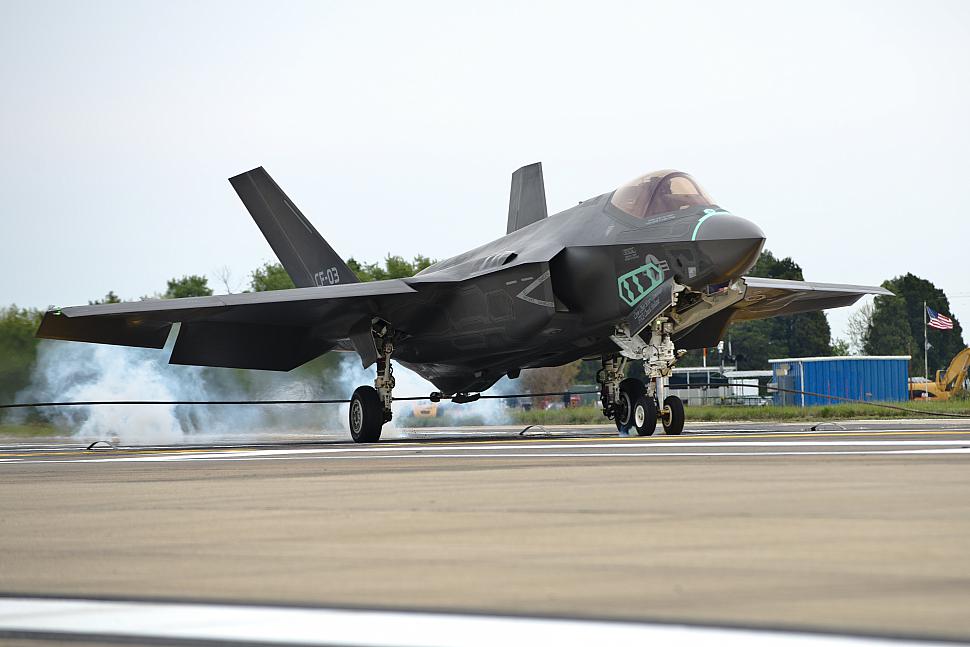Fighter Jet News
F-35 Lightning II News
F-35 achieves three major flight test milestones on same day
May 30, 2014 (by
Eric Schnaible) -
In three separate flight tests on May 27, Lockheed Martin F-35 Lightning II aircraft demonstrated air-to-air combat capability, completed the first flight test with the next level software load and accomplished a landing at the maximum test speed and drop rate.

In the Point Mugu Sea Test Range airspace off the Central California coast, an F-35B demonstrated the jet’s air-to-air combat capability when it sequentially engaged two aerial targets with two AIM-120 Advanced Medium Range Air-to-Air Missiles (AMRAAM) during a Weapon Delivery Accuracy mission.
Test pilot Lt. Col. Andrew ‘Growler’ Allen tracked two maneuvering drone targets, making the very first dual AMRAAM shot from any F-35 variant, and the first live AMRAAM shot from the F-35B Short Take Off and Vertical Landing (STOVL) variant.
“The U.S. Marine Corps, which operates F-35Bs, will be the first military service branch to attain combat-ready Initial Operational Capability (IOC) in 2015,†said J.D. McFarlan, Lockheed Martin's vice president for F-35 Test & Verification. “This Weapon Delivery Accuracy test highlighted the air combat capability that will give Marine aviators a decisive combat edge in contested airspace.â€
The F-35’s internally-carried AIM-120 AMRAAMs are a beyond-visual-range air-to-air missile capable of all-weather day-and-night operations and considered a “fire-and-forget†missile using active target radar guidance.
Flying from Edwards Air Force Base, an F-35A flew a 1.9 hour mission with the first-ever load of Block 3i hardware and software. Block 3i is the next level of capability and is planned to support U.S. Air Force F-35A IOC in 2016.
The F-35C, designed for aircraft carrier operations, completed a landing at its maximum sink speed to test the aircraft’s landing gear, airframe and arrestment system at Naval Air Station Patuxent River, Maryland. “Five sorties were conducted, building up the maximum sink rate test condition of 21.4 feet per second, which represents the maximum sink speed planned for this test,†McFarlan said. During the tests, the F-35C did three arrestments, several touch and goes and one bolter. The landings were to demonstrate structural readiness for arrested landings on an aircraft carrier at sea.
Fleet-wide, the F-35 has, to date, amassed more than 17,000 flight hours, with all three variant aircraft at the F-35 Integrated Training Center at Eglin AFB, Florida, surpassing the 5,000 sorties milestone this week.

USNavy F-35C (CF-03) flown by LCdr. Dyckman makes a fly-in arrestment landing at NAS Patuxent River. [Lockheed Martin photo by Dane Wiedmann]
Test pilot Lt. Col. Andrew ‘Growler’ Allen tracked two maneuvering drone targets, making the very first dual AMRAAM shot from any F-35 variant, and the first live AMRAAM shot from the F-35B Short Take Off and Vertical Landing (STOVL) variant.
“The U.S. Marine Corps, which operates F-35Bs, will be the first military service branch to attain combat-ready Initial Operational Capability (IOC) in 2015,†said J.D. McFarlan, Lockheed Martin's vice president for F-35 Test & Verification. “This Weapon Delivery Accuracy test highlighted the air combat capability that will give Marine aviators a decisive combat edge in contested airspace.â€
The F-35’s internally-carried AIM-120 AMRAAMs are a beyond-visual-range air-to-air missile capable of all-weather day-and-night operations and considered a “fire-and-forget†missile using active target radar guidance.
Flying from Edwards Air Force Base, an F-35A flew a 1.9 hour mission with the first-ever load of Block 3i hardware and software. Block 3i is the next level of capability and is planned to support U.S. Air Force F-35A IOC in 2016.
The F-35C, designed for aircraft carrier operations, completed a landing at its maximum sink speed to test the aircraft’s landing gear, airframe and arrestment system at Naval Air Station Patuxent River, Maryland. “Five sorties were conducted, building up the maximum sink rate test condition of 21.4 feet per second, which represents the maximum sink speed planned for this test,†McFarlan said. During the tests, the F-35C did three arrestments, several touch and goes and one bolter. The landings were to demonstrate structural readiness for arrested landings on an aircraft carrier at sea.
Fleet-wide, the F-35 has, to date, amassed more than 17,000 flight hours, with all three variant aircraft at the F-35 Integrated Training Center at Eglin AFB, Florida, surpassing the 5,000 sorties milestone this week.
Courtesy of Lockheed Martin Corporation
Related articles:
Forum discussion:
Tags
- F-35 fleet surpassed 16,000 flight hours ( 2014-05-11)
- F-35 completes first live fire missile test ( 2013-10-31)
- F-35 Lightning II Program Surpasses 10,000 Flight Hours ( 2013-10-09)
- F-35A completes 1st in-flight missile launch ( 2013-06-06)
- F-35 Lightning II news archive
Forum discussion:
- Start a discussion about this article in the F-35 forum.
Tags
